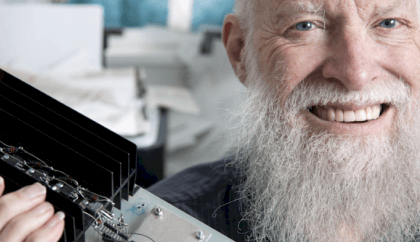What's All This Analog Stuff, Anyhow?
August 22, 2015
on
on

Analog by Design
This article originally appeared in Elektor.POST #84 on August 22, 2014. Don't miss any updates, take out a free membership to Elektor.POST.
First things first: Happy Birthday, Bob!
Robert Allen Pease was born on this same day, August 22, in 1940. After earning a B.Sc. degree in Electrical Engineering in 1961, he started working at George A. Philbrick Researches, the company which released the K2-W, the first affordable and commercially available general computing (tube-based) op-amp. In 1976 he moved to San Francisco to work at National Semiconductor, where he would stay during his entire career. At National, Bob designed some of the most successful analog chips, like the LM331 voltage-to-frequency converter, or the LM337 (a negative version of Bob Widlar's LM317 linear voltage regulator). His passion for answering questions and sharing knowledge led him to give analog seminars all over the world, write regular columns and even have his own TV show. Bob quickly became the face of National and a true legend in analog design, keeping his charisma, kindness and humility.
Unfortunately, while he was driving back from a memorial service for Jim Williams (his friend, colleague, and also an analog expert) in June 18, 2011, he crashed his old 1969 Volkswagen Beetle and was killed in the accident. The electronics community had lost two heroes of the golden age of analog design in less than a week.
After their acquisition of National Semiconductor, Texas Instruments compiled some nice resources, including part of his lab notes. These are definitely worth checking out in order to understand Bob's unique way of communicating his ideas (with a big sense of humor)! During his career, he was a member of the exclusive "eccentric genius" electrical engineering fraternity, which is a group that today continues to breathe life into an industry that can, at times, be overly bureaucratic, impersonal, and bottom line driven. It's well known that Bob's desk was a huge mess (aka. Pease's disaster area!). Though I'm sure in his mind, ideas were kept tidy, perfectly arranged and crystal-clear. Long live creative mess!
Picture: © Jason Doiy | EEWeb
This article originally appeared in Elektor.POST #84 on August 22, 2014. Don't miss any updates, take out a free membership to Elektor.POST.
First things first: Happy Birthday, Bob!
Robert Allen Pease was born on this same day, August 22, in 1940. After earning a B.Sc. degree in Electrical Engineering in 1961, he started working at George A. Philbrick Researches, the company which released the K2-W, the first affordable and commercially available general computing (tube-based) op-amp. In 1976 he moved to San Francisco to work at National Semiconductor, where he would stay during his entire career. At National, Bob designed some of the most successful analog chips, like the LM331 voltage-to-frequency converter, or the LM337 (a negative version of Bob Widlar's LM317 linear voltage regulator). His passion for answering questions and sharing knowledge led him to give analog seminars all over the world, write regular columns and even have his own TV show. Bob quickly became the face of National and a true legend in analog design, keeping his charisma, kindness and humility.
Unfortunately, while he was driving back from a memorial service for Jim Williams (his friend, colleague, and also an analog expert) in June 18, 2011, he crashed his old 1969 Volkswagen Beetle and was killed in the accident. The electronics community had lost two heroes of the golden age of analog design in less than a week.
After their acquisition of National Semiconductor, Texas Instruments compiled some nice resources, including part of his lab notes. These are definitely worth checking out in order to understand Bob's unique way of communicating his ideas (with a big sense of humor)! During his career, he was a member of the exclusive "eccentric genius" electrical engineering fraternity, which is a group that today continues to breathe life into an industry that can, at times, be overly bureaucratic, impersonal, and bottom line driven. It's well known that Bob's desk was a huge mess (aka. Pease's disaster area!). Though I'm sure in his mind, ideas were kept tidy, perfectly arranged and crystal-clear. Long live creative mess!
Picture: © Jason Doiy | EEWeb
Read full article
Hide full article



Discussion (4 comments)
Craig McAdam 9 years ago
James Mahoney 9 years ago
Douglas Dwyer 9 years ago
george Gonzalez 8 years ago
As for Bob Pease, I had many email exchanges with him, questions about his voltage regulator chip, and he was very helpful. I had an offhand inquiry about the LM199 voltage reference and he not only sent back some handwritten notes, he sent along some very specially aged LM199's, with several months of aging graphs, for free. I can't imagine how much those used to cost!
He was a little bit grouchy though. One time he visited my house and we were going to play with my electronics stuff, but my wife made an offhand comment about how the new VW bugs were cuter thn the old ones, and that was the end of that visit! Also maybe because I didn't have any beer on hand. My mistake!